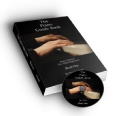How to Read Music
Do you want to get the most out of playing piano?
If you do, then you must learn how to read music!
From this page you will find information on:
The notes on the staff
The elements of the piano "grandstaff"
The time signature
The values of notes
The values of rests
How to count notes and rhythms (very important!)
Sharps, flats, and naturals
Key signatures
Then you can put it all together by playing some simple melodies!
The Notes on the Piano Staff and Keys
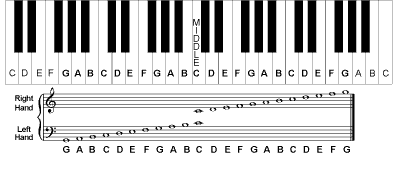
To learn how to read music, first you need to know what you are reading! This diagram shows where the notes on the staff are located on the piano keyboard.
The top staff, known as the "treble" or "G" clef represents the notes played by the right hand. The bottom staff, known as the "bass" clef or "F" clef represents the notes played by the left hand. Middle "C" is the "C" closest to the middle of the keyboard, and is also known as "middle C" because it is the note that is the middle line between both staves. The two staves together are known as the "grandstaff."
The Elements of the Piano Grandstaff
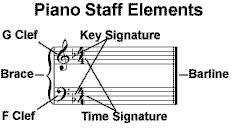
As stated above, the G clef denotes the staff of music played by the right hand. It is called the "G" clef because it is shaped like an medieval style letter "G." Notice that it forms a "cross" over the "g" line. The "G" clef is also called the "treble" clef.
The left hand plays the notes on the F clef, also known as the "bass" clef. It is shaped like a medieval style letter "F." Its' two dots are on top and below the "F" line.
The brace connects the two staves together to create one piano "grandstaff."
The key signature is the sharps, flats or lack of that tell us the key the music is written in. Shown here is one flat, Bb, which is the signature for the key of "F."
More About Key Signatures, Sharps Flats and Naturals
The time signature is the two stacked numbers at the beginning of a piece of music. The top number is the number of beats per measure, and the bottom number tells us what each beat is worth. Here, 4/4 means 4 beats per measure, and each beat is worth a quarter note.
The barline divides the staff vertically into easy to read sections called measures. Shown above is a double barline which denotes the end of a piece of music.
Time Values of Notes and Rests

To begin your quest on how to read music and understand musical notation, you will need to know the time value of the notes you are reading, as well as what pitch the notes represent.
The whole note is held for the "whole" measure, which is four counts or beats in a musical piece with a 4/4 time signature. It is sometimes used to fill a whole measure in 3/4 time, which would be 3 counts or beats.
The half note gets half the measure in 4/4, or two beats or counts.
The quarter note gets one beat or count in any music that has "4" as the lower number in the time signature.
The eighth note gets one half of a beat or count in any music that has "4" as the lower number in the time signature.
The sixteenth note gets one quarter of a beat or count in any music that has "4" as the lower number in the time signature.
VERY IMPORTANT - Click This Link! This is the basics of how to read music!
More About Note Values: How To Count Notes
Rest Values
Rest Values are the same as the note values listed above. Rest represent "no music" or "silence" for the duration of the rest.
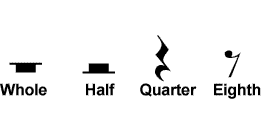
The quarter rest and eighth rest are distinctive enough to make them easy to recognize. The whole rest and half rest are easily confused, though. One way to remember is that the whole rest looks like a "hole" in the ground, and the half rest looks like a hat. Also, the whole hangs from the second line from the top of the staff, and the half sits on the middle line.
Put It All Together! - Let's Play Some Easy Music!
Here we will put it all together. We will read music - the staff, the notes, the counting, plus some basic chords in the left hand.
Try to play the first four measures from Ludwig Van Beethoven's "Ode To Joy" and the early American classic "Yankee Doodle," and don't forget to have fun as you learn how to read music!
Here you'll also find free pdf piano lesson downloads of these songs!
Let's Play Some Easy Music!
Click to learn more about:
More About the Piano Staff
More About Key Signatures
More About Time Signatures
How to Count Notes
Let's Play Some Easy Music
Start Playing Piano Today with the Piano Guide Quick Start Course!
Easy to follow step-by-step lessons designed for adult beginners. The next best thing to private lessons!
What You'll Learn:
- Notes on the piano/keyboard
- Proper fingering
- C major scale
- Chords
- How to read music
- And much more!
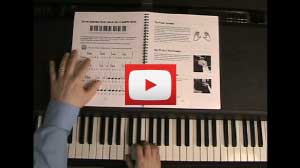
Video lessons - watch as I play everything for you.
